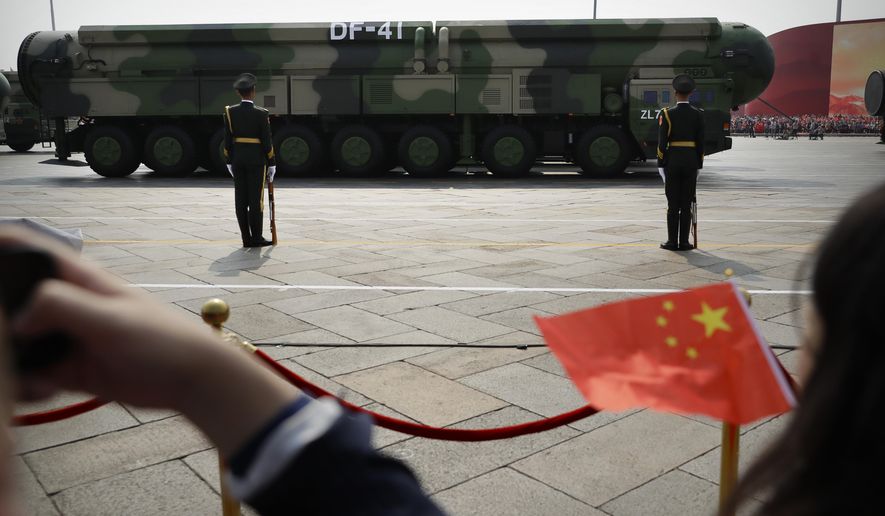The commander of American military forces in the Pacific is pushing back against Chinese government claims that a three-nation pact to build nuclear submarines for Australia poses a danger of nuclear weapons proliferation.
Adm. John Aquilino, who heads U.S. Indo-Pacific Command, told reporters in Indonesia after a recent round of U.S.-led military exercises in the region that the sole country creating nuclear weapons fears is China.
“We’re watching the largest military buildup in history since WWII by the PRC,” he said in reference to Pentagon assessments on increasingly aggressive armed forces expansion efforts by China, formally the People’s Republic of China.
Adm. Aquilino commented more broadly on Chinese government opposition to the effort by Australia, the United Kingdom and the United States to build nuclear-powered submarines for the Australian navy under a security arrangement called AUKUS.
“This program has nothing to do with nuclear weapons,” the admiral said at a joint press conference Friday with Indonesian military chief Gen. Andika Perkasa in that country’s South Sumatra province.
“If you’d like to talk about nuclear weapons and the concern for a nuclear arms race, all you have to do is look into the PRC,” Adm. Aquilino said. He added that he has read reports of Chinese complaints about the AUKUS submarine program.
SEE ALSO: Taliban seized more than $7B in U.S.-provided weapons when Afghan government fell
“The only nation increasing the nuclear arsenal right now is the PRC,” the four-star admiral said. China has “300 nuclear silos going in as we sit here today.
“So let’s look at actions, and let’s not talk about words,” he said.
‘Strategic breakout’
China’s nuclear buildup has alarmed the Pentagon at a moment when the U.S. military is modernizing all of its nuclear forces to meet the challenge of deterring both China and Russia.
In the past, nuclear deterrence was geared toward countering Soviet and then Russian nuclear forces. However, China’s government is rapidly expanding its nuclear forces with the construction of missile silos in western China. Satellite photos have shown as many as 350 silo sites.
In recent congressional testimony, Adm. Charles Richard, commander of U.S. Strategic Command, described China’s nuclear buildup as a “strategic breakout” comparable to the Soviet Union’s nuclear buildup in the 1960s.
The most visible portion of the current Chinese buildup is the expansion from zero to 360 silos for solid-fueled intercontinental ballistic missiles in western China in a few years, Adm. Richard testified in May.
The hundreds of silos are expected to house a new DF-41 multiwarhead missile, defense officials have said. The number of warheads carried by each DF-41 is not known. Intelligence estimates put the number of multiple, independently targetable reentry vehicles, or MIRVs, at four to 10 warheads.
China is believed to have obtained multiwarhead technology from the United States during U.S.-Chinese space cooperation during the Clinton administration.
Other Chinese nuclear developments of concern include a rapid expansion of road-mobile ICBMs, nuclear-armed H-6N bombers equipped with air-launched ballistic missiles, and new nuclear-tipped missile submarines.
Another major worry centers on China’s testing of an orbiting hypersonic missile that can attack from multiple angles and is difficult to detect with current missile warning systems.
China’s defense minister, Wei Fenghe, has dismissed concerns about the ICBM silos in western China as “moderate and appropriate.”
“That means being able to protect our nation’s security so that we can avoid the catastrophe of a war, especially the catastrophe of a nuclear war,” Mr. Wei told reporters during a visit to Singapore in June.
Disinformation on AUKUS
Chinese state media in July launched what U.S. analysts say is a disinformation campaign to persuade regional states to oppose the AUKUS nuclear submarine deal.
Two Chinese government nuclear research agencies, China Arms Control and Disarmament Association and the China Institute of Nuclear Industry Strategy, issued a report in July urging the international community to stand against the nuclear submarine program.
The report said the program must be halted to “safeguard the integrity, authority and effectiveness of the international nuclear nonproliferation regime.”
After the report’s circulation, Chinese engineer Zhao Xuelin, with the China Institute of Nuclear Industry Strategy, claimed that weapons-grade nuclear material sent to Australia could produce 64 to 80 nuclear weapons.
Mr. Zhao said the program will violate the Nuclear Non-Proliferation Treaty.
The State Department has said China’s refusal to conduct arms control talks on its nuclear forces is a violation of the Nuclear Non-Proliferation Treaty.
Taiwan in crosshairs
Adm. Aquilino responded to the Chinese accusations during multinational military exercises in Indonesia called Garuda Shield. It involved about 5,000 troops.
The exercises are held annually with Indonesian and U.S. military forces. This year’s drills also included forces from Australia, Singapore and Japan, along with observers from nine other nations.
“Our forces, operating together, delivers a deterrent effect against any destabilizing effort in the region,” said Adm. Aquilino, who cited recent Chinese military provocations around Taiwan as an example.
“The destabilizing actions by the PRC as it applied to the threatening activities and actions against Taiwan is exactly what we are trying to avoid,” he said. “I can tell you from my seat, I spend every waking minute doing everything to ensure we are preventing conflict in the region. Every day, we try to prevent war.
“We’ll continue to help deliver a free and open Indo-Pacific and be ready when we need to respond to any contingency,” the admiral said.
Multiple news outlets in Asia, including The Associated Press, reported on his remarks.
A spokesman for U.S. Indo-Pacific Command told The Washington Times that a transcript of Adm. Aquilino’s remarks was being prepared. Later, however, Navy Cmdr. Tiffani Walker, a spokeswoman for the command, said no transcript or audio of the admiral’s press conference would be made public.
• Bill Gertz can be reached at bgertz@washingtontimes.com.




Please read our comment policy before commenting.